现在完成时四种用法的时间状语
- 格式:doc
- 大小:29.50 KB
- 文档页数:2


Lead in一般过去时导入:一般过去时的概念一般过去时表示过去某个时间发生的动作或存在的状态。
I lost my pen.(过去时)I have lost my pen.(现在完成时)过去时一般表示过去所发生的动作或存在的状态。
“我把笔丢了”,说话人只是想告诉对方在过去的某一个时间里他的笔丢了,仅此而已。
(仅仅是在陈诉过去的一个事实,与现在没有关系)New lesson一.现在完成时的构成:助动词have/has(not) +动词过去分词She has turned on the lights.肯定式:have/ has+过去分词否定式:haven’t/hasn’t+过去分词疑问式:把have/has 提到主语前面肯定回答:Yes,…have/has否定回答:No,…..haven’t/hasn’t二.用法1.表示过去发生的动作对现在造成的影响或结果.例如:She has gone. 她走了. She went in the past.(She is not herenow.)I have just cleaned my hands.我刚洗过手。
(“洗手”是发生在过去的动作,对现在造成的结果是“手干净了”)I have closed the door. (The door is close now.)She has turned on the lights. (The lights are on now.)He has written his name on the blackboard. (The name is on the blackboard now.)Mother has cooked the dinner. (We can have dinner now.)You have seen the film. (You know what the film is about.)We have cleaned the classroom. (The classroom is clean now.)2. 表示动作发生在过去,并且一直延续到现在,甚至还可能继续延续下去。
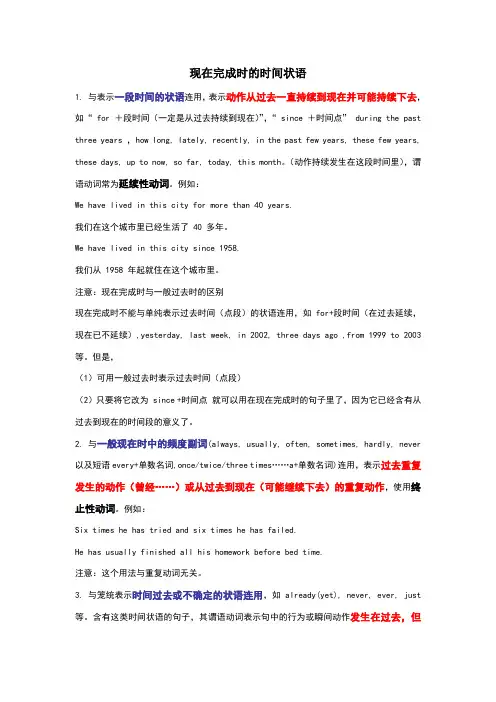
现在完成时的时间状语1. 与表示一段时间的状语连用,表示动作从过去一直持续到现在并可能持续下去,如“ for +段时间(一定是从过去持续到现在)”,“ since +时间点” during the past three years ,how long, lately, recently, in the past few years, these few years, these days, up to now, so far, today, this month。
(动作持续发生在这段时间里),谓语动词常为延续性动词。
例如:We have lived in this city for more than 40 years.我们在这个城市里已经生活了 40 多年。
We have lived in this city since 1958.我们从 1958 年起就住在这个城市里。
注意:现在完成时与一般过去时的区别现在完成时不能与单纯表示过去时间(点段)的状语连用,如for+段时间(在过去延续,现在已不延续),yesterday, last week, in 2002, three days ago ,from 1999 to 2003等。
但是,(1)可用一般过去时表示过去时间(点段)(2)只要将它改为 since +时间点就可以用在现在完成时的句子里了,因为它已经含有从过去到现在的时间段的意义了。
2. 与一般现在时中的频度副词(always, usually, often, sometimes, hardly, never 以及短语every+单数名词,once/twice/three times……a+单数名词)连用,表示过去重复发生的动作(曾经……)或从过去到现在(可能继续下去)的重复动作,使用终止性动词。
例如:Six times he has tried and six times he has failed.He has usually finished all his homework before bed time.注意:这个用法与重复动词无关。
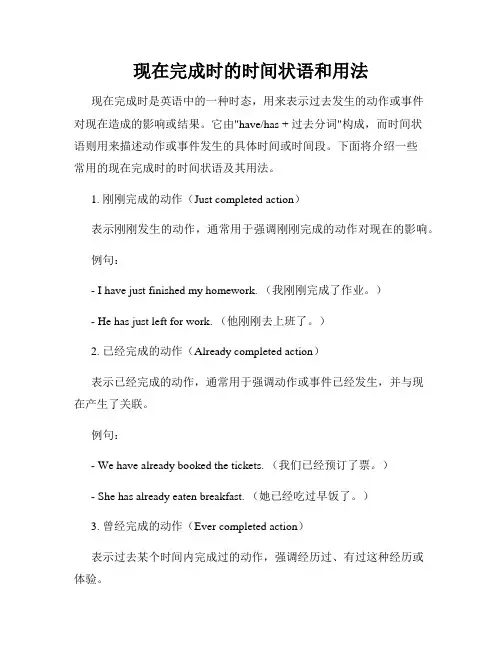
现在完成时的时间状语和用法现在完成时是英语中的一种时态,用来表示过去发生的动作或事件对现在造成的影响或结果。
它由"have/has + 过去分词"构成,而时间状语则用来描述动作或事件发生的具体时间或时间段。
下面将介绍一些常用的现在完成时的时间状语及其用法。
1. 刚刚完成的动作(Just completed action)表示刚刚发生的动作,通常用于强调刚刚完成的动作对现在的影响。
例句:- I have just finished my homework. (我刚刚完成了作业。
)- He has just left for work. (他刚刚去上班了。
)2. 已经完成的动作(Already completed action)表示已经完成的动作,通常用于强调动作或事件已经发生,并与现在产生了关联。
例句:- We have already booked the tickets. (我们已经预订了票。
)- She has already eaten breakfast. (她已经吃过早饭了。
)3. 曾经完成的动作(Ever completed action)表示过去某个时间内完成过的动作,强调经历过、有过这种经历或体验。
例句:- Have you ever been to Paris? (你曾经去过巴黎吗?)- They have ever won the championship. (他们曾经获得过冠军。
)4. 到目前为止的动作(So far completed action)表示到目前为止已经完成的动作,常用于描述达到的进度或程度。
例句:- I have read two chapters of the book so far. (到目前为止,我已经读了两章了。
)- They have finished half of the project. (到目前为止,他们已经完成了一半的项目。
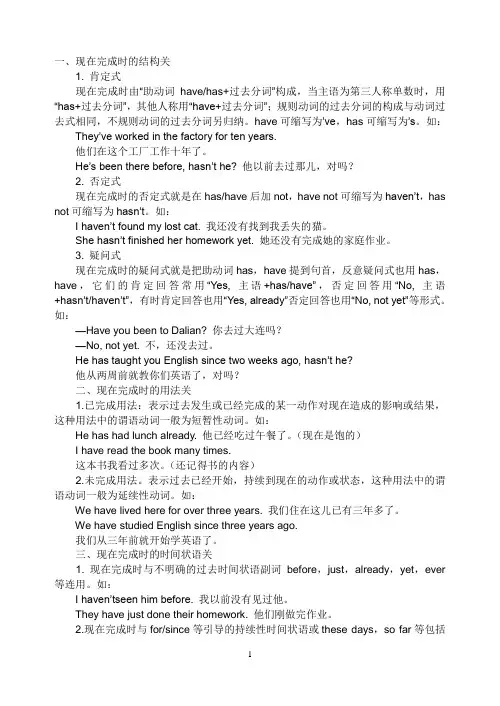
一、现在完成时的结构关1. 肯定式现在完成时由“助动词have/has+过去分词”构成,当主语为第三人称单数时,用“has+过去分词”,其他人称用“have+过去分词”;规则动词的过去分词的构成与动词过去式相同,不规则动词的过去分词另归纳。
have可缩写为’ve,has可缩写为’s。
如:They’ve worked in the factory for ten years.他们在这个工厂工作十年了。
He’s been there before, hasn’t he?他以前去过那儿,对吗?2. 否定式现在完成时的否定式就是在has/have后加not,have not可缩写为haven’t,has not可缩写为hasn’t。
如:I haven’t found my lost cat. 我还没有找到我丢失的猫。
She hasn’t finished her homework yet. 她还没有完成她的家庭作业。
3. 疑问式现在完成时的疑问式就是把助动词has,have提到句首,反意疑问式也用has,have,它们的肯定回答常用“Yes, 主语+has/have”,否定回答用“No, 主语+hasn’t/haven’t”,有时肯定回答也用“Yes, already”否定回答也用“No, not yet”等形式。
如:—Have you been to Dalian? 你去过大连吗?—No, not yet. 不,还没去过。
He has taught you English since two weeks ago, hasn’t he?他从两周前就教你们英语了,对吗?二、现在完成时的用法关1.已完成用法:表示过去发生或已经完成的某一动作对现在造成的影响或结果,这种用法中的谓语动词一般为短暂性动词。
如:He has had lunch already. 他已经吃过午餐了。
(现在是饱的)I have read the book many times.这本书我看过多次。
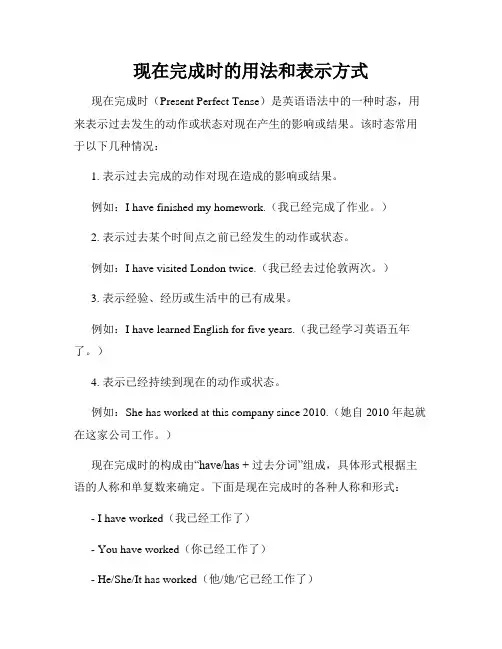
现在完成时的用法和表示方式现在完成时(Present Perfect Tense)是英语语法中的一种时态,用来表示过去发生的动作或状态对现在产生的影响或结果。
该时态常用于以下几种情况:1. 表示过去完成的动作对现在造成的影响或结果。
例如:I have finished my homework.(我已经完成了作业。
)2. 表示过去某个时间点之前已经发生的动作或状态。
例如:I have visited London twice.(我已经去过伦敦两次。
)3. 表示经验、经历或生活中的已有成果。
例如:I have learned English for five years.(我已经学习英语五年了。
)4. 表示已经持续到现在的动作或状态。
例如:She has worked at this company since 2010.(她自2010年起就在这家公司工作。
)现在完成时的构成由“have/has + 过去分词”组成,具体形式根据主语的人称和单复数来确定。
下面是现在完成时的各种人称和形式:- I have worked(我已经工作了)- You have worked(你已经工作了)- He/She/It has worked(他/她/它已经工作了)- We have worked(我们已经工作了)- You have worked(你们已经工作了)- They have worked(他们已经工作了)在使用现在完成时时,还需注意以下几点:1. 现在完成时常和表示时间的状语连用,常见的状语有:- for + 一段时间(例如:for two years,for a long time)- since + 具体时间点或事件(例如:since yesterday,since I was born)- already(已经)、yet(仍然)、just(刚刚)等。
2. 现在完成时通常和现在的延续性动词连用,如:live(居住)、work(工作)、study(学习)、teach(教导)等。
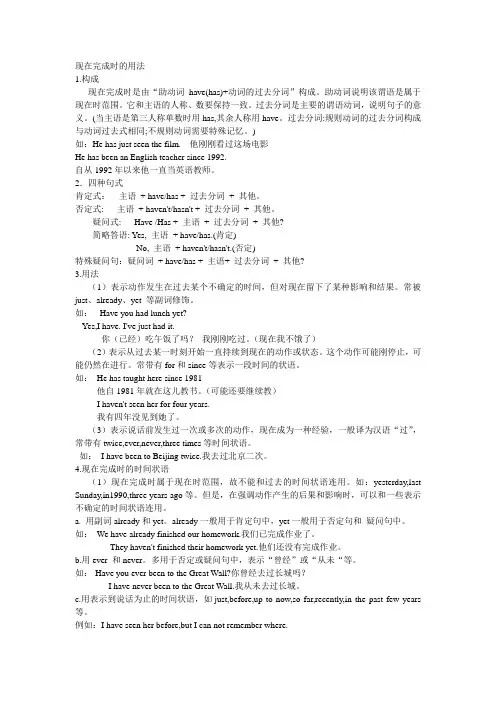
现在完成时的用法1.构成现在完成时是由“助动词have(has)+动词的过去分词”构成。
助动词说明该谓语是属于现在时范围。
它和主语的人称、数要保持一致。
过去分词是主要的谓语动词,说明句子的意义。
(当主语是第三人称单数时用has,其余人称用have。
过去分词:规则动词的过去分词构成与动词过去式相同;不规则动词需要特殊记忆。
)如:He has just seen the film.他刚刚看过这场电影He has been an English teacher since 1992.自从1992年以来他一直当英语教师。
2.四种句式肯定式:主语+ have/has + 过去分词+ 其他。
否定式: 主语+ haven't/hasn't + 过去分词+ 其他。
疑问式: Have /Has + 主语+ 过去分词+ 其他?简略答语: Yes, 主语+ have/has.(肯定)No, 主语+ haven't/hasn't.(否定)特殊疑问句:疑问词+ have/has + 主语+ 过去分词+ 其他?3.用法(1)表示动作发生在过去某个不确定的时间,但对现在留下了某种影响和结果。
常被just、already、yet 等副词修饰。
如:-Have you had lunch yet?-Yes,I have. I've just had it.你(已经)吃午饭了吗?我刚刚吃过。
(现在我不饿了)(2)表示从过去某一时刻开始一直持续到现在的动作或状态。
这个动作可能刚停止,可能仍然在进行。
常带有for和since等表示一段时间的状语。
如:He has taught here since 1981他自1981年就在这儿教书。
(可能还要继续教)I haven't seen her for four years.我有四年没见到她了。
(3)表示说话前发生过一次或多次的动作,现在成为一种经验,一般译为汉语“过”,常带有twice,ever,never,three times等时间状语。

现在完成时的四种用法现在完成时是英语中一个很重要的时态,也是很容易弄错的一个时态。
归纳起来,现在完成时共有四种主要用法,现分别解说如下:一、现在完成时表示影响该用法的现在完成时表示一个过去发生的动作在过去已经完成,并且这个过去发生并完成的动作对现在有影响或结果,同时说话者强调的或感兴趣的就是这个影响或结果,如汉语说“他已离开这个城市了”,其中的“离开”肯定发生了,它对现在的影响或结果就是“他现在已不在这个城市了”;又如汉语说“有人把窗户打破了”,显然“打破窗户”这一动作发生在过去,并且在过去已经完成了,但说话人强调的重点是打破窗户对现在的影响——窗户现在仍是破的。
如:He has left the city. 他已离开这个城市。
(结果:他不在这个城市。
)Someone has broken the window. 有人把窗户打破了。
(结果:窗户仍破着。
)I have lost my pen. 我把钢笔丢了。
(结果:我现在无钢笔用。
)He has finished his work. 他把工作做完了。
(结果:他现在可以做其他的事了。
)二、现在完成时表示持续该用法的现在完成时表示一个过去发生的动作或开始的状语在过去并未完成或结束,而是一直持续到现在,并且有可能继续下去(也可能到此结束),如汉语说“他在我们学校教书已有30年了”,显然“他在我们学校教书”是从30年前开始,并且一直教到现在,已经持续了30年;又如汉语说“自上个星期以来他一直很忙”,显然“忙”是从上个星期开始的,并且这一“忙”就一直忙到现在。
如:He has taught in our school for 30 years. 他在我们学校教书已有30年了。
He has been busy since last week. 自上个星期以来他一直很忙。
英语微信群是目前学习英语最有效的方法,群里都是说英语,没有半个中文,而且规则非常严格,是一个超级不错的英语学习环境,群里有好多英语超好的超牛逼的人,还有鬼佬和外国美眉。
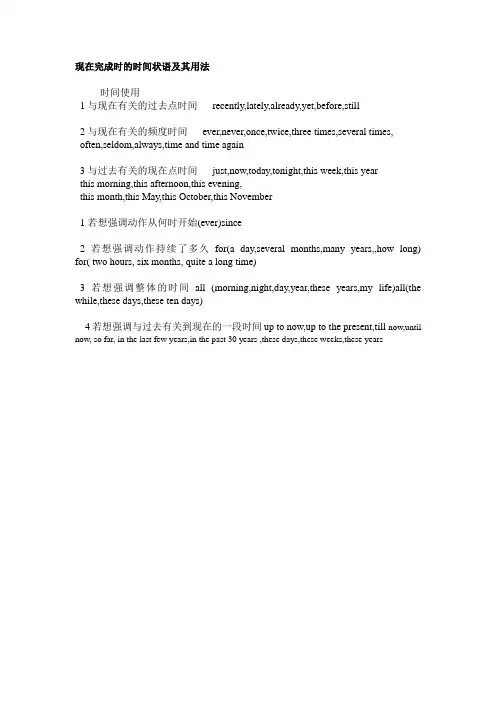
现在完成时的时间状语及其用法
时间使用
1与现在有关的过去点时间recently,lately,already,yet,before,still
2与现在有关的频度时间ever,never,once,twice,three times,several times, often,seldom,always,time and time again
3与过去有关的现在点时间just,now,today,tonight,this week,this year
this morning,this afternoon,this evening,
this month,this May,this October,this November
1若想强调动作从何时开始(ever)since
2若想强调动作持续了多久for(a day,several months,many years,,how long) for( two hours, six months, quite a long time)
3若想强调整体的时间all (morning,night,day,year,these years,my life)all(the while,these days,these ten days)
4若想强调与过去有关到现在的一段时间up to now,up to the present,till now,until now, so far, in the last few years,in the past 30 years ,these days,these weeks,these years。
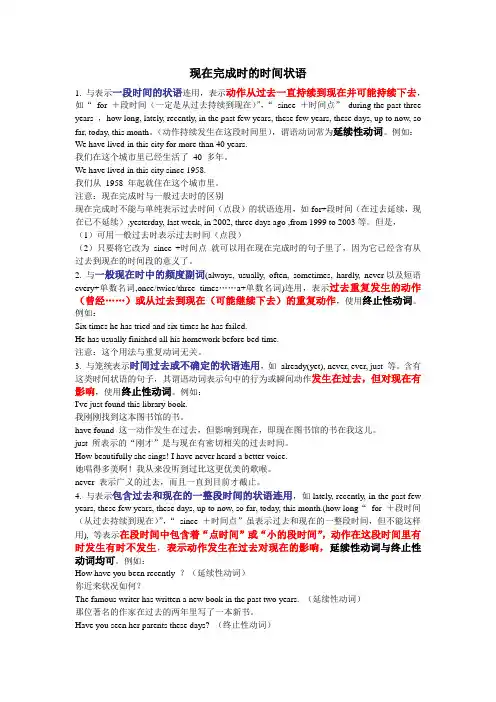
现在完成时的时间状语1. 与表示一段时间的状语连用,表示动作从过去一直持续到现在并可能持续下去,如“for +段时间(一定是从过去持续到现在)”,“since +时间点”during the past three years ,how long, lately, recently, in the past few years, these few years, these days, up to now, so far, today, this month。
(动作持续发生在这段时间里),谓语动词常为延续性动词。
例如:We have lived in this city for more than 40 years.我们在这个城市里已经生活了40 多年。
We have lived in this city since 1958.我们从1958 年起就住在这个城市里。
注意:现在完成时与一般过去时的区别现在完成时不能与单纯表示过去时间(点段)的状语连用,如for+段时间(在过去延续,现在已不延续),yesterday, last week, in 2002, three days ago ,from 1999 to 2003等。
但是,(1)可用一般过去时表示过去时间(点段)(2)只要将它改为since +时间点就可以用在现在完成时的句子里了,因为它已经含有从过去到现在的时间段的意义了。
2. 与一般现在时中的频度副词(always, usually, often, sometimes, hardly, never以及短语every+单数名词,once/twice/three times……a+单数名词)连用,表示过去重复发生的动作(曾经……)或从过去到现在(可能继续下去)的重复动作,使用终止性动词。
例如:Six times he has tried and six times he has failed.He has usually finished all his homework before bed time.注意:这个用法与重复动词无关。

现在完成时全面解读一.概念:现在完成时(Present Perfect Tense)过去发生并且已经完成的动作对现在造成影响或后果,也可以表示过去某一时间开始并一直持续到现在的动作或状态。
二. 时间状语:1. just, already, yet, ever, recently, before, twice, three times, so far, up to now, till now2. since+(过去时间)时间点, since +一段时间+ ago, 与since +从句(从句用一般过去时)since yesterday, since last week, since last Monday, since last month, since last spring, since last term, since last year, since 1949, since 1978;since half an hour ago, since two days ago, since three weeks ago, since four months ago, since five years ago;since I became a teacher, since he went to college, since she joined the army;3. for+一时间段for an hour, for two days, for three weeks ,for four months, for five years4. in the last few hours, in the last few days, in the last few weeks, in the last few months, in the last few years5. in the past few hours, in the past few days, in the past few weeks, in the past few months, in the past few years三. 谓语构成:have/has + 过去分词四.用法说明:1.表示过去某个时间发生的动作对现在的影响或结果,常与just, already, yet, recently, before, twice, three times等时间状语连用,如:I have seen the film already. 我已经看过那部电影了。
现在完成时用法详解1. 现在完成时的定义现在完成时既可表示过去发生的动作对现在所造成的结果或影响(此时通常连用的时间状语有already, yet, just, ever, before),也可表示动作从过去某时间开始,一直持续到现在,并且还有可能持续下去(此时通常连用的时间状语有this month / week / year, these days, recently / lately, in the past few + 时间段, since +时间点, for + 时间段)。
如:I have just finished my work. 我把工作做完。
Have you ever been to Beijing? 你曾经去过北京吗?I have lived for ten years. 我在这儿住了十年了。
We have studied here since 2003. 我们自2003年来就在这儿读书了。
2. 现在完成时的结构现在完成时由“have / has + 过去分词”构成。
3. 现在完成时的应用(1) 非持续性动词go, come, leave, borrow, buy, die, join的完成时的肯定式不能与时间段连用,若要接用时间段状语,则应换成相应的持续动词或状态动词。
如:He has left. 他走了。
(from )He has been away for an hour. 他走了一个小时了。
Can I borrow that book? 我可以借那本书吗?How long can I keep the book? 这本书我可借多久?注意:非持续性动词的否定完成时可与时间段状语连用。
如:He has not borrowed the book since then. 从此以后,他再也没有借这本书了。
(2) have / has been to 表示曾经去过某地,但现在不在那儿;have / has gone to表示现在已去某地,现在不在这儿。
现在完成时过去发生的而与现在的情况有关的事或状态,或者是从过去某时到现在为止这一段时间内发生的情况。
【一定与现在有关系】现在完成时的用法:“继续”、“完成”、“经验”、“结果”。
My father has worked here for nearly 30 years. 【从过去继续到现在的动作或状态】I have visited the state of Michigan twice.【过去某时刻发生的动作使现在有某种经验】I have just finished my homework.【现在已经完成的动作】I have lost my dictionary.【过去发生了某动作导致现在的结果】四种用法的时间状语:继续since, for, How long~?, all, etc.经验often, ever, never, before, once, ~times完成already, just, yet, etc.结果不需要时间状语表示继续的现在完成时【一定要和现在有关系,否则只需要用一般过去时】I began to study English three years ago.I still study English now.I have studied English since three years ago.常用的时间状语:for+时间;since+过去某时。
“for+时间”可以和各种时态连用,千万不要产生误解,认为它只用于完成时。
He studied in Beijing University for 4 years in 1960’s.此句是过去时,与现在无关,只是在过去的二十世纪六十年代发生的事,同样可以用“for+时间”。
“sinc e+过去的时间”表示从过去某时开始的动作或状态一直继续到现在,此时,since是介词。
I’ve learned to dance since three years ago.We have known each other since we were children.注意:通常since引导的从句的动词是用过去时,而主句原则上是用现在完成时,但用“it’s+时间~”开始的句子例外。
现在完成时1. 构成方法have/has +动词的过去分词现在完成时的否定式是在have/has的后面直接加not;变为疑问句时,要将have/has提到主语之前。
2. 现在完成时态常与一些时间状语连用:yet, already, just, before, ever, never, recently, so far, till/until, up to now, in thea) since + 过去一个时间点(1980, March)I have been here since 1989.b) since + 一段时间+ agoI have been here since five months ago.c) since + 从句Great change have taken place since you left.d) It is + 一段时间+ since 从句(过去时)It is twelve years since I became a student.4. For 引导的表示一段时间的状语They have been in Canada for ten years.My brother has kept this book for 5 weeks. (特殊疑问句)→How long has your brother kept this book?5. 现在完成时与一般过去时的区别一般过去时的时间状语:yesterday , last week, two days ago, in 2000, just now …6. have gone to, have been to, have been ina. Jim has gone to London with his family.(He is on his way or in London now)b. Jim has been to London before.(He is back now.)c. Jim has been in London for two weeks.(He went to London two weeks ago and he is still there)7. 延续性动词与终止性动词终止性动词不可延续,所以不可与表示一段时间的状语连用.误: I’ve left my hometown for 10 years.正: I’ve been away from my hometown for 10 years.误: He has borrowed this book for a week.正: He has kept this book for a week.但它们的否定式可以与一段时间状语连用.Eg. I haven’t bought any new clothes for three months.8. 终止性动词与表示一段时间的状语连用时, 将终止性动词转化为持续性动词come →be in… go →be in…die →be dead borrow →keepbuy →have join →be in…/ be a …memberleave →be awayEg. I came here for three years. (×)→I have been here for three years.The old man died for two months. (×)→The old man has been dead for two months.。
现在完成时之二:Since和for的用法Since 和 for 的用法表示过去已经开始持续到现在的动作或状态常用的时间状语有:for, since, how long, so far, these days等。
Since+过去点的时间,for+一段时间(数词+量词),此划线部分用how long提问。
一、since短语或从句表示过去的动作延续至今,since之后的时间为一点。
如:Mr. Smith has worked here since 1984. 1984年以来,史密斯先生一直在这工作。
He’s learned about 5,000 English words since he went to college. 他上大学以来大约学了五千个英语单词。
二、for短语表示动作延续多长时间,for的宾语为时间段。
如:We have known each other for twenty years. 我们认识有二十年了。
I haven’t seen her for a long time. 我好久没有见到她了。
练习:用since和for填空1) __for___two years 2) ___since____ two years ago 3) ___since____ last month4) __since____ 1999 5) ___since____ yesterday 6) ____since___ 4 o’clock7) ___for___ 4 hours 8) ____since___ an hour ago 9) ____since___ we were children10) ___since__ lunch time 11) ____since__ she left here1. He has lived in Nanjing __since______ the year before last.2. I’ve known him ____since______ we were children.3. Our teacher has studied Japanese ____for_____ three years.4. She has been away from the city ______for_____ about ten years.5. It’s about ten years ______since____ she left the city.2.短暂性转换延续性①arrive at/in sw. get to/reach sw. come/go/move to sw.→ be in sw./at school/at home/on the farm/be here/be there 1) He got to Beijing five minutes ago.He has gotten to Beijing for 5 minutes.2) I moved to the USA last year.I have moved to the USA since last year.3) I went home yesterday.I have gone home for 2 days.4) They came here last week.They have come here since last week.②come/go back, return → be back come/go out → be out1) He came out (出来)two years ago.He has come out for 2 years.2) We return(返回) to Fuzhou yesterday.We have been back to Fuzhou since yesterday.③become → be1) I became a teacher in 2000.I ________ __________ a teacher for _________ _________.2) The river became dirty last year.The river _________ _________ dirty for _________ __________.④close → be closed open → be open1) The shop closed two hours ago.The shop ________ _________ _________ for _________ _________.2) The door opened at six in the morning.The door ________ ________ ________ for six hours.⑤get up → be up die → be deadleave sw. → be away from sw.fall asleep/get tot sleep → be asleepfinish/end → be over marry → be married1) I got up two hours ago.I ________ ________ ________ since ________ ________.2) He left Fuzhou just now.He _______ ________ ________ _________ Fuzhou for five minutes.3) My grandpa died in 2002.My grandpa _______ _______ ________for _______ ________.4) The meeting finished at six.The meeting ________ ______ ______ for six hours.5) I got to sleep two hours ago.I ________ _________ _________ since _________ __________.6) They married in 1990.They ________ _________ __________since _________.⑥start/begin to do sth. → do sth. begin → be on1) I began to teach at this school in 1995.I ____ ____ at this school since ____.2) The film began two minutes ago.The film ____ ____ ____ for ____ ____.⑦borrow → keep lose → not have buy → have put on → wear catch/get a cold → have a cold get to know → know1) They borrowed it last week.They _________ _________ it since __________ __________.2) I bought a pen two hours ago.I _________ _________ a pen for ________ __________.3) I got to know him last year.I _________ __________ him since __________ __________.4) I put on my glasses three years ago.I __________ __________ my glasses for _________ _________.⑧have/has gone to → have been in1) He has gone to Beijing.He ____ ____ _____ Beijing for two days.⑨join the league/the Party/the army→ be a league/a Party member/a soldier→ be a member of the league/the Party→ be in the league/the Party/the army1) He joined the league in 2002.He ________ _________ a _________ _________ for two years.He ________ __________ a __________ ___________ the __________ for two years.He ____________ ___________ ___________ the league for two years.2) My brother joined the army two years ago.My brother __________ __________ a ___________ for ___________ ___________.My brother ___________ ___________ in ____________ ___________ for two years.3.汉译英1)这本字典我已买了三年了。
现在完成时是由“have/has+过去分词”构成,一般表示影响、结束、继续和经历四种意思。
现在完成时的否定句是在have/has后面直接加上not;一般疑问句是将have/has置于主语之前;特殊疑问句是将疑问词置于一般疑问句之前。
现在完成时句子结构①肯定句:主语+have/has+动词的过去分词(p.p) (V-ed) +宾语(或者其他)。
②否定句:主语+have/has not (haven' t/hasn' t) +动词的过去分词(p.p) (V-ed) +宾语.③一般疑问句:Have/Has+ 主语+动词的过去分词(p.p) (V-ed) +宾语(或者其他) ?肯定回答:Yes, I/they/we/you have.或Yes, she/he/人名has.否定回答:No, I/they/we/you haven' t.或No,she/he/ 人名hasn' t.④特殊疑问句:特殊疑问词+一般疑问句(have/has+ 主语+过去分词+其他) 现在完成时的用法用法一:表示过去发生或已经完成的某一动作对现在造成的影响或结果.常与just(刚刚),already(已经),never(从来没有),ever(曾经),before(以前),yet(仍然),),how many times(多少次),so far(迄今为止),during the past(last)three years(最近三年来)等连用。
用法二:表示过去已经开始,一直延续到现在的动作或状态.时间状语有:①for+表示一段时间的词语,例句:I have taught English for 19 years.我教了19年英语。
②since+表示过去时间点的词语,例句:He has been at this school since 1986.自从1986年以来,他一直在这所学校。
③since+表示过去的时间状语从句,例句:I have lived here since I was born.我从出生起就住在这里。
第1章一、现在完成时1、定义:现在完成时描述的是过去发生而与现在情况有关的事或状态,或是从过去某时到现在为止这一段时间中发生的情况,换言之,现在完成时表现的是从过去到现在的事情。
2、现在完成时的形成①现在完成时的肯定句句型:主语(l/we/you/第三人称复数)+have+过去分词②现在完成时的否定句句型:主语+have/has+not+过去分词③现在完成时的一般疑问句句型:Have/Has+主语+过去分词?④现在完成时的特殊疑问句㈠疑问词作主语时:句型:疑问词(主语)+have/has+过去分词+……?备注:who在这里是“谁”的意思,可以指代单数,亦可指代复数,所以调语动词相应的也可以使用单数或复数。
㈡疑问词作主语以外的成分时:句型:疑问词+have/has+主语+过去分词+……?知识积累:“主语+have/has”的缩写形式:I have→I’veY ou have→Y ou’veWe have→We’veThey have→They’veHe has→He’sShe has→She’sIt has→It’s3、现在完成时的用法“have/has+过去分词”表示现在完成时,有“继续”、“经验”、“完成”、“结果”等用法。
①继续:例:I have not seen Molly Brown since last Wednesday night.自从上个星期三晚上以来,我再也没见过莫莉·布朗。
②经验:例:Some people in Tokyo also say that they have seen aliens.在东京也有一些人声称他们曾经见过外星人。
③完成:例:Has he finished his trip to the space yet?他的太空旅行结束了吗?④结果:例:My brother has become an astronaut.我哥哥已经成为一句宇航员了。
备注:现在完成时这一时态就是动作在过去发生,但也一定要和现在有关系,否则就用过去时。